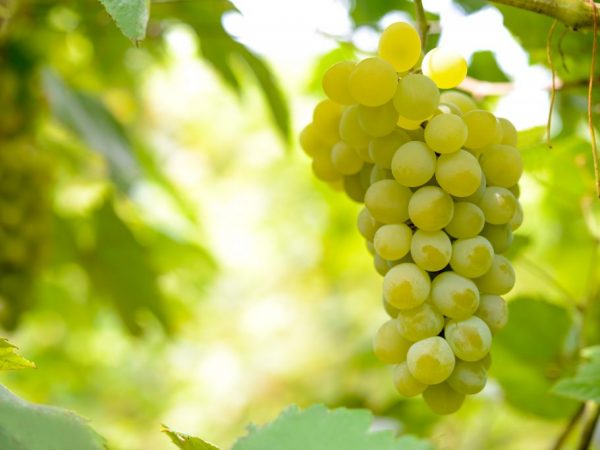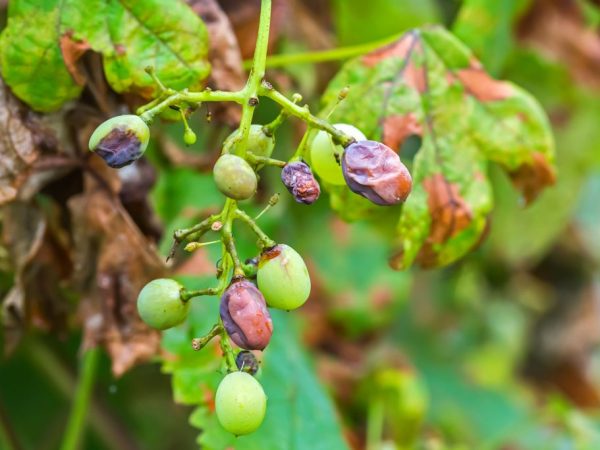Description of the Bianca grape variety
There are many varieties of white grapes. Each has a different ripening period, characteristics and purpose of use. The Bianca grape is a technical variety that is used to make wines. It ripens early and bears fruit well.

Description of the Bianca grape variety
Characteristics of grapes
The Bianca variety is used to make white table and fortified wines. Due to its raw material properties, it is also used for the production of cognac.
Bianca grapes have unique organoleptic qualities, mild flavor and aroma of almonds. Grappa is also prepared from the pomace - grape vodka.
Description of the bush
Bushes of medium size. The leaves have a smooth dark green surface. Shoots grow actively, each has 2-3 inflorescences.
Plants planted with cuttings take root well and give a crop already in the third year. Brushes have a cylindrical shape, weight - 100-150 g.
Description of fruits
The berries are small and round. The weight of each does not exceed 2 g. The color of the fruit is yellowish with a green tinge.
The pulp is juicy, with a rich taste. The amount of sugar is 28%, so the berries are used to make sweet and semi-sweet wine. Ripe fruits have an acidity of 7%, alcoholism - 14%. There are floral or honey notes on the palate.
Growing grapes
The Bianca variety grows well in any area, it is only important to fertilize the soil. If it is clayey, the vine is securely anchored.
If the soil has high acidity, it is diluted with lime. For wine species, light and warmth are important, so it is better to plant them on the south side. The larger the slope, the better.
Landing in the soil
The optimal period for planting seedlings of Bianca grapes is the first half of October. It is important to take into account the peculiarities of the local climate. Seedlings are planted before frost begins, the soil should not be too wet.
Description of the rules for planting seedlings:
- The depth of the fossa is 50-55 cm. This is important for root protection in winter.
- Cuttings are planted in dense rows. The distance between seedlings should be 50-60 cm, between rows - 2-3 m.
- In the southern area, plants are rooted at the end of March. In the north - in late April or early May. The air temperature should be at least 12 ° С, and the ground temperature should be 8 ° С-10 ° С.
Plant care

The plant must be pruned regularly.
To increase resistance to frost, the upper roots of the plants are cut off. This is important because they are poorly protected and suffer from frost in winter. This affects the health of the entire plant. There should be no more than 5 cm of root above the ground.
Also, the vine is pruned. 3 eyes are left on one shoot. Thanks to this, the branches are not overloaded, the yield increases.
Fertilizer
The Bianca variety needs to be fertilized every year. Fertilizer is applied in the spring before shoots begin to bloom. Use 200 g of superphosphate and 100 g of ammonium sulfate per plant. Phosphorus is important for the formation of inflorescences and fruit ripening. There are 2 methods of fertilization.
Description of the rules for fertilization:
- ditches 40 cm deep are made between the rows, fertilizer is applied to them and covered with soil;
- at a distance of 40 cm from the seedlings, they dig holes, throw fertilizer into them and sprinkle them with earth.
At the end of June, fertilizer is applied with nitrogen or nitrophos. In early August, potassium is fertilized in the form of foliar dressings.
For feeding take:
- copper - 1.5 g;
- sugar - 3 tbsp. l .;
- boron - 1 g;
- ash - 1 l.
The ingredients are mixed in 10 liters of water and poured into the root of the plant. Potassium fertilizers are applied in the same way. This promotes the synthesis of sugar, which is important for wine grapes.
Watering
The grapes yield good yields with moderate soil moisture. It is important to water it frequently in hot weather.
You can dig small holes near the bushes and pour water into them. On a large plot, it is more convenient to dig a trench and moisten the bushes through it. To keep moisture longer, the soil around the plants is loosened.
Diseases and pests
Bianca resists many diseases, but sometimes suffers from Alternaria.
Also, the variety is opposed to phylloxera. It is an insect that harms the foliage of grapes. Due to the high sugar content, berries are loved by wasps and birds.
Fight disease

Disease can kill an entire crop
Alternaria is a fungal disease that significantly reduces crop yields and can kill the plant if left untreated.
Brown spots with purple edging appear on the leaves. They gradually increase. It is better to fight this disease with chemical methods. Treatment of bushes with Bordeaux mixture is effective.
Description of the rules for preparing the mixture:
- lime and copper sulfate are bred in different dishes;
- lime is well mixed with water and filtered;
- the vitriol solution is filtered and gradually combined with lime.
The bushes are processed 5-6 times a season. Berries are eaten no earlier than 20 days after processing. Also used drugs "Trichodermin", "Quadris", "Rapid Gold" and "Skor".
Pest control
To protect the bushes from wasps, dishes with poison and sugar are placed between the rows. This serves as a decoy. Insect nests are also burned, but this is an ineffective method because it is difficult to find all the hives.
To protect the crop from birds, firecrackers, ribbons and scarecrows are used, but these are temporary and ineffective methods of control. The best option is to use a mosquito net or any other net with small holes.
Prophylaxis
Alternaria can actually be avoided if organic grape residues are removed in time and correct agricultural practices are followed. Preventive spraying with Bordeaux mixture is useful.
It is important to apply mineral fertilizers on time: they increase immunity. Treatment of plants with fungicides is also effective.
Conclusion
The Bianca grape variety is considered a good technical type for cultivation. It has a pleasant sweetish taste, gives a good harvest and is resistant to many diseases and temperature extremes.
This variety is used for the preparation of sweet and semi-sweet wines, as well as cognac. Sometimes he undergoes alternaria, but the disease can be really avoided thanks to prevention.


